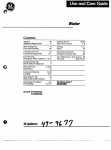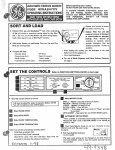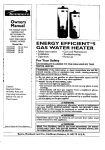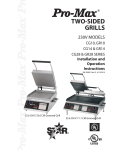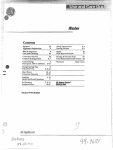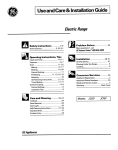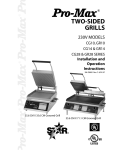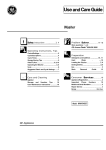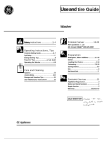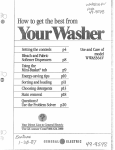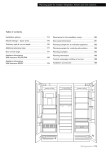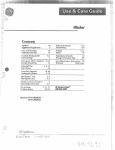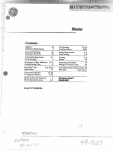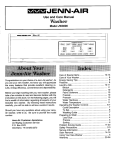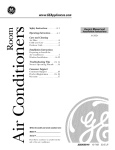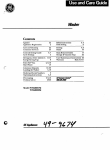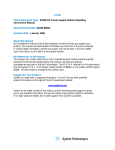Download GE WWA8810M User's Manual
Transcript
Washer safe~ instructions ....................3. 4 operating instructions, mps Agitator...........................................................2~ BleachDispenser.........................................l0 ControlsSetting Guide.............................8. 9 CycleSetiings.............................................6. 7 Energy-SavingTips...................................... 10 FabricSoftener Dispenser.........................lo [email protected],5,11 Mini.BasketwTub..........................................l2 Operating the Washer ..............................4. 5 Preparation Detergents, Other Additives.............. 15–19 Hard Water ....................................................18 Loadingthe Washer................................4. 14 Sorting Clothes.............................................13 Stains..............................................................20 Stain RemovalGuide...................................21 ~O~SU~~F ~~~W~G~S ...................27 Appliance Registration..................................2 Model and Serial Numbers ..........................2 Repair Service .................................................2 Warranty ........................................BackCover careandcleaning LimestoneDeposits.............................16. 26 Storage & Vacation Tips.............................26 ---------,... -,., $: ‘~.. . . ~e. Model W!.8810M —- m~~ usm LP YOU.** savetimeandmoney. It is intended to help you operate and maintain your new washer properly. Keep it handy for answers to your questions. If you don’t understand something or need more help, write (include your phone number) Consumer Affairs GE Appliances Appliance Park Louisville, KY 40225 Before you request service,.. check the Problem Solver section. It lists causes of major operating problems that you can correct yourself. If you receiveda damagedWasllera e a Immediately contact the dealer (or builder) that sold you the washer. You’11find them on a label on the lower left side near the fro~~t, These numbers are also on the Consumer Product Ownership RegistrationCard that came with your washer. Before sending in this card, please write these numbers here: ModelNumber -. Serial Number Use these numbers in any correspondence or service calls concerning your washer. * FOR YOUR SAFETY you smell gas: To obtain a Spanish language version of this book, call GE Answer Center@ 800.626.2000 consumer information service. Para obtener la versi6n en espafiol de este manual, name a GE Answer Center”, servicio de informaci6n para el consumidor, telefono 800.626.2000. Iif L ~.’ All washing instruction terms in this book conform to the Care Labeling Rule establisheciby the Federal Trade Commission, January 1984. r, , ,I~,_ \ , I~. 6 ~f j~~~ ~~~~ ~~~~~~~ T{){lbtainservice, see the Consunler Scl.vices page in the b:lck of this 1300k. v~~e.1.e pi-o[ld0( our scrj’ice and w:in[y(]~l[(3be []leased. If for son~e First, contact the people who serviced your appliance. Explain why yOLI are no[ pleased. In most cases, this will ~c~lve~heproblelm. NEXT. if you are still not pleased. write all the ciet:~ils—iilclLlcling voLirDhonenumber-to: FINALLY, if yoLIrproblem is still not resolved, write: Major Appliance Consumer -... Action Panel ) 20 North “WackerDrive [ .— ;,! Cilicago, IL 60606 -. ,,fi./“.. .,. —4.....—A Louisvillc, 1~.’i40225 .-.. --,..___ —__ ._.__.__...,_..“..“....._ __.. — .——...—. i ‘l 1 ~ I I I ‘ usethis applianceoniy foritsintendedpurpose as described in this Use and Care Book. 3 l;gj~ ..: e This washermust be properly instiiled and iocatedinaccordance with the Instillation Instructions before it is used. If you did not receive an installation Instructions sheet with your washer, you can obtain one by contacting the service location nearest you. —Properlygroundto Codorm tith alI go~~erning codes and ordinances.Follow details inInstallation Instructionse —Instailor store whereit wiIl notbe exposed totemperatures below freezing —or ex~osed to onnect to a properly rated, protected and sized power supply circuit to avoid electrical overload. .--; -Connect to adequate Plumbinz and drain facilities as described ifi the Ins&llation instructions. s Turn off water faucets when the washer is not in use to relieve pressure on hoses and valves, and to n~ir]imizeleakage if a hose or valve should break or I“upture. eDonotwash or dry articlesthat havebeenCiealledin,washedin, soaked in,or spottedwith combustibleor explosiveSubstances (suchas wax,paint,gasoline, degreasers,dry. cleaning solvem@9 keroseme9 etc.)whichmay igniteor explode.Do notadd thesesubstancesto the washwater.Donot use thesesubstances around your washer anWoI-dryer during operation. wARNm&HYDRoGEN GASis produced by the chemicalaction within your heaterand the gas can accumulateinthe water heater andor water been used fora period pipes Uhot water has of weeks or longer.HYDROGENGASCAN two water not BE EXPLOSIVE UNDERTmSE cI~cms~A~cEs. SOtOpreventthe possibilityof damage or injury,if you have not used hot water for two weeks or more9or move into a reside~lcein which the hot water system nlay not have been used for some time3turn on all hot water faucek md allow them to run for several minutes before using any electrical appIiancewhich is connectedto the hot watar system. This wi~lailow any hydrogengas to escape. Since the gas is flanlmable~do not smoke or use an open flame or appliance during this process. s W!~endisconnecting this appliance ><$~ PUJ1~JY~~leP~Ugralher ihanthecordto ,4,:: f.k~ , # ;>< avoid daInage to [he cord or junction of cord and plug. Make sure that the cord is lLIc;I[cdso that it will not be stepped on, tripped ()~ir or oti]crwisc subjected to damage or stress. . , /-;, . ...——— -.—. .. ..-=——, ..-, _________ “-) <. .-.——-—-------...... . ..... .... . ...... * KeepalIlaund~ aids(suchas detergents,bleaches,fabtic softeners,etc*)outof thersach Ofchijdren,preferablyin a locked cabinet.Observeallwmings on containerlabelstoavoidpersonalinjury. @Keeptheareaaroundandunderneath yaurappliancesfreefromthe accumulationof combustiblematerials, suchas lint,paper,rags,chemicals,etc. ~Keeptheflooraroundyourappliancescleanand dryto reducethepossibilityof slipping. * Tominitize thepossibtiityof electric shock,unp~ugthisappliancesfromthe .,powersupplybeforeattemptingany maintenanceor cleaning(excepttheremovaland cleaningofthelintfilter). NOTE:Tming theCycleSeIector hob to anOW positiondoesNOT disconnecttheappfiancefromthe powersupply. 9Donot Wper titi controls, s Do notoperatethisapplianceif’it is damaged, malfunctioning, partial]y disassembled, orhas missingorbrokenparts,includinga damaged cord orplug. * Neverclimbonor standonthewashertop, s Donot‘washfiberglassarticlesin yourwasher. Skinirritationcouldresultfromtheremaining particlesthatmaybepickedupbyclothing duringsubsequentwasheruse. *Thelaundryprocesscanreducethe flameretardancyoffabrics.Toavoid sucha result,thegarment manufacturer’s careinstructionsshould befollowedverycarefully. For washeroperation oDonotleavewasherlidupduringcycle.Thiswill stopthewashandspinactionandprevent completionof thecycle. SAW ~ms~ ms~~uc~~o~? WARNING—TOreduce the tisk offire,electricshock, or injury topersons when using your appliance,read the IMPORTANT SARETY INSTRUCTIONSbefore operating thisappliance. \ / ....... ,., .-, .+ .... ~0~~~~~ ~~~ ~~~~~~~ (continued) e .3,ddmeasured amount of ~Position the Filter-Flopan on the de{ergent.See Detergents and agitator.Lint will collect in the pan O[her.4dditivessection for for easy removal when the wash informationon detergents and is finished. other laundry additives. NOTE: Do not use the Filter-Flo @Loadclothesinto wash basket, pan as a wash basket. Do not put be~~g~mefulnot to overload. any items to be washed in the Clothesshouldbe belowretaining Filter-Flo pan. ring. See How to Load your Washer ~See How to Use Bleach sectionfor more information. Dispenser section for information on the Bleach Dispenser. @See How to Use Fabric Softener Dispenser section for more informationon the Fabric Softener Dispenser. ~For informationon bleachesand fabric softeners,see OtherLaundry Productsseetion. ~Closethe tid. Washerwill fill but not agitateor spin with the lid open. settingthe controls Use the Controls Setting Guide to help you make the proper selections. @ Select Wash/Spin Speed. @Select Water Level. ALL: Washer is less than one-third full of clothes. ‘“’r-DIUM: Betweenone-thirdand one-halffull. LARGE: Between one-half and two-thirdsfull. EXTRA LARGE: Over two-thirdsfull. kfINI-BASKET See How to Use the Mini-Basketn’ Tubsection. If }OUwant to increase level after you’ve made a selection, turn knob to “RESET” and select ne~;~level. @ Select WasWrise Temperature. Cold rinse will be automatically provided with use of l?ermPress and Pre Wash Cycles. (An extended cool-down spray rinse and cold-water deep rinse are provided to minimize setting of wrinkles.) @ Select ExtraRinse, if desired. Turning control to “ON’ will provide a second deep rinse in the Regular Cycle. If no Extra Rinse is desired, turn control to “~~.,, @ Push Cycle Selector knob in and turn clockwise to your selected wash setting. @ Pull Cycle Selector knob out to start the washer. If you wish to change setting after washer has started. ~ush m Cycle Selector kn~Gin to ~ stop the washer and reset to the new position. Setting can be changed at any time. ,-. — Tws To mLP You SELECT Regularcyeles— , For most cottons,linens and work and play clothes with normal soiling,“Extra Rinse” can be selected,if desired, as an automatic extension of the Regular Cycles (turn Extra Rinse knob to “ON “). Extra Rinse can also be set as an independentcycle—for example, to rinse and spin clothes that have been in the wash basket longer than normal. tiea~ DUV Etira LargoCapacity FrAaRl#aAOrfp~fi~ agldarcyc/8s PeratBnent Press UGlllSOIL❑ Nonw HrAw EstrnC/Oar/ing Cycle mw,,0‘,m Wm,Q,,W For extremely soiled clothes that require EXTRA DIRT REMOVAL before going through a regular wash. I Hea~ DutyExtra I.ergs Capacity rcy’’s.mkcv s I AlilOE~RW= “ Om SIAAl I Extra Cleaning Cycle Extra clean cycles— — For modern fabrics with heavy or oily soil. A second rinse is provided to help remove the additional detergent that is required for these soils. See Detergent Guide. 1 — Hea~ DutyExtra brge Capaci~ - :R!n:e ohE::;Mg~ H. kgularCycles PenrranentPress andKnitsCycles Om . STAII1 Ucnr SOILa NofluAl E MfAw AUfO~ PraWashCycle RINSE I Etim ClenningCycle :. ~. }i-, -~-,, 1 I“ If‘ ~: \ I — A combination of agitation and sozikfor more effective polyester knits laundering. Plus an extended cool-down spray rinse is provided to minimize the setting of wrinkles. I ExtraCleaningCyclo I k .x--, ‘. ~. ,) -J ——-. —— -- —.__. .— _____ .. . —-,— —.-——...”.. _ \ } I 1 ..-. -—— . . . . -——.—.-—. . . ..— - ,. .,.,. .. . . .. ..—— . ..— .-—. . . . . . . . . .. ... . . . $ 1 e+ Permanent Press Cyel+ For permanent press loads such as shirts, blouses, dresses and similar wearing apparel with normal soiling.An extended cool-down spray rinse is provided to minimize wrinkling. Weaw Dutv Ma ~ flfm — .,. larRa Cnuacifv off PI*SS flogular Cycles Potnlisn9nfPfess UolnSouel Uwuu a Huw I Mm Clenn[ngCycle I Use with most soaking aids to loosen embedded soils and stains. Wut?xaro.in W.,IW HeeW DutyExtraLarge.Capaci~ Pam7af70nt Press RegularCycles so&CFI* o UGlil SCiLB MOSMUu Extf8 Cleaning Cycle inEachsetting(Approximate what Happens I I Cycle I Regular CycIes I I Selector Settings Heavy I Normal I I Extra ~ Clean I I Ijight Soil , , Spin Rinse .sI)in 2nd Rinse . I 3% 3Z 3 3Z 3 3 7 i.~y: 7 :k‘2y, 7 +~y: I Soak Minutes) Permanent Press and I Knits Cycles 1Pre-Wash P. Press I Knits I 3X ~~ -. 3 3 25 2X 25 7 3 ? 4K 4X I I 4X I controlssetting Guidefordifferentfabricsandloads Wmwspin WashWater Cottons andLinens White/Colorfast Bright/Noncolorfast Normal/Norma] Norma~ormal Hot or Warm Warm or Cold Regular Cycles Regular Cycles Normal or Light Soil Setting Normal or Light Soil Setting Work Clothes, Dungarees, etc. Heavy soil Normali’Normal Hot Extra Cleaning Cycles Normal,Wormal Hot or Warm Regular Cycles Heavy or Normal Setting, depending on load size Normal Setting Normal/Gentle Hot Extra CIeaning Cycles NormaVGentle warm P. Press & Knits Cycles Heavy or Normal Setting, depending on load size Permanent Press Setting Normal/Gentle Warm P. Press& Knits Cycles Permanent Press Setting DeIicates Silks, Wools; Blends of Silk and Wool Gentle/Gentle Gentle/Gentle warm warm P. Press & Knits Cycles P. Press& Knits Cycles Knits Setting Knits Setting Rayon and Acetate Gentle/Gentle warm P. Press & Knits Cycles Knits Setting Down-filled garments, if machine washing is recommenced Gentle/Gentle Warm P. Press& Knits Cycles Baby Clothes—-Sturdy,such as Diapers, Nightgowns, Shirts, Pads, Sheets, Receiving Blankets, Coveralls ———— Baby Clothes-Delicate Yormal/Normal Hot Regular Cycles Gentle/Gentle Warm P. Press& Knits Cycles i min. soak then ?ormal/Normal warm Regular Cycles ; min. soak then Warm Regular Cycles Load Average soil Permanent Press, Treated Cottons, Blends with Cottons Heavy or oily soil Average or light soil Synthetic~-Polyester, Nylon, Acrylic Knits and WovenFabrics Sturdy Blankets—Wool, Part-Wool, cotton t31ankets-Synthetic, Electric speed Temperature cycle setting Normal or Light Soil Setting, depending on amount of soil ~-~ setting Light soil Jormal/Normal Curtains—DO NOr MACHINE WASH FIBERGLASS icntle/Gentle Hot or Warm P. Press& Knits Cycles Permanent Press Setting {-8 ~~ ~. Chenile Bedspreads, Robes’K’; ;entle/Gentle Hot or Warm P. Press & Knits Cycles Permanent Press Setting \ -; }:” Slipcovers, Draperies, Batl]mats & Rt]gs;*’;’ /orn]al/Nornlal Hot or Warm Regular Cycles Normal Setting Denims (especially Indigo Blue Jeans) and other fabrics that bIeed Cold or Warm Regular Cycles Normal Setting Iormal/Normal ~ t i / \ \ Rubber-coatc(i Items. Lamina;cd Fa13rics$Vi[lyl. Piastics an(i Ar[iclcs ~vithPlastic ‘[’rim ~entle/GentIe Warm !Varm P. Press & Knits Cycles P. Press & Knits Cycles -~ \ \ ; ! Permanent Press Setting m., ,..f Pcrrnancnt Press oZ{il=_,.l!-J depcrtding on anlo~llltof soil ,.,-. i {Z [i \ — ——————-—-----.’, \ I ! .7 \:. ,$ f -:> ‘-~ -——,._, \ .— ..——-——..—_— —— -..””.—-. --...--.,.. I RefertoGarment Manufacturers’ Liquidchlorine type. Only non-chlorine bleach when needed. If colorfast is unusually soiled, use hot water. Use maximum detergent recommendedin Detergent Guide. Use Extra Cleaning, Large or Small Setting dependingon load size. See How to Operate YourClothes Washer section. Use Extra Rinse if desired. JVhiteor colorfast, liquid chlorine type. Non-colorfast, only non-chlorine bleach ~vhenneeded. Use maximum detergent recommended in Detergent guide. \Vhiteor colorfast, liquid chlorine type. Non-colorfast, only non-chlorine bleach when needed. Small loads reduce wrinkling. Use maximum detergent recommended in Detergent Guide. Use Extra Cleaning Cycles, See Tips to Help You Select Settings section. Use Extra Rinse if desired. White or colorfast, Iiquid chlorine type. Non-colorfast, only non-chlorine bleach when needed. If unusually soiled, use hot water. Use maximum detergent recommended in Detergent Guide, For heavy or oily soil on sturdy garments, use Extra Cleaning, Large or Small Setting depending on load size. See How to Operate Your Clothes Washer section. Small loads reduce wrinkling. A’obleach Wash oIzlyif recommended by the garment manufacturer. Follow instructions carefully. k Wash in your washer only if recommended by the garment manufacturer. Idom needed. If needed, use only ‘ n-chlorine bleach. No bleach s Wash frequently to fluff up the down and retain the garment’s warmth. Wash separately. Wet down gives off an odor which maybe absorbed by other garments. Odor disappears when garment is dry. Treat heavily soiled areas with liquid detergent or paste made of water and granular detergent. Close zippers. Wash 2 or 3 at a time or add towels to balance. GARMENT MUST BE TUMBLE DRIED. You may prefer to use a mild type detergent. Do baby clothes separately. Pretreat spots. Rinse diapers, nightgowns, pads and sheets after use. Keep diapers in a covered pail of cold water and conditioning agent like Borateem brand. ./[ }Vhiteor colorfast, liquid chlorine type. ‘-i. I careLabels Only non-chlorine bleach when needed, Youmay prefer to use a mild type detergent. Do hand-knit garments by hand or in MiniBasket’”tub. See How to Use Mini-BasketNtub swtion. NObleach Fill washer, add detergent and allow to dissolve before adding blanket. Do one blanket at a time. Pretreat heavily soiled spots with liquid detergent. N(Jbleach ~n electric blanket, sew a strong piece of cloth over plug to protect blanket and washer from damage. Do one blanket at a time. Pretreat heavily soiled spots with liquid detergent. JVhitcor colorfast, liquid chlorine type. Vacuum out loose dirt before washing. If unusually soiled, use Normal/Gentle Wash/Spin Speed. Wash onlv . 2 or 3 rugs or mats at onc time. Shake before washin~ to remove excess dirt. For nc~v“indigo b~eans, wash at least 3 times in very small loads with full water fill. Je~Ils need ample room to move to avoid white lines at c~eases. May discolor plastic washer parts. Subsequent washings will reduce discolorations, but will probably never eliminate it. The stained parts will not discolor subsequent washing loads. Tumble on FLUFF (No Heat). —-’ <. g B ~ “.x ;()l>lc;lch “i ‘“d ! =>>j, ij? $ .._= ! g i j J g Pillows arc inade of different materials-dacron, fiber, foam, polyester, natural feathers and (Iown. Llany pi]lows can be machine washed, but i?zaizl(factt~rers’ care labels )~z1/sI bc,fi)llovi~ed [.(]rqt~(lly. If ~vashin: is recommended, check pillows for weak seams or holes and me~~dto prcvc~]iescape of fefithers or filling. Fill washer, add detergent and agitate for several rnim.]tes to diss(>lvedctergerz[.Add ~~,vo pillows at a time to balance load. Use exha large water level. ——. Energy-saving Tips If your clothes and householditems don’t look clean and fresh after washing$you will probably re-wash them.. and that means you’ll waste energy. Remember to sort your clothes carefully,and load them properly,select correct cycles, use enough detergent and choose u water temperaturewarm eilo~ighto release at~dget rid of soil. ~Use Hot Wash—upto 150°F.—OJZ a regular basis or?lywhen washing heavily soiled articles-such as work and play clothes. o Under normal soil conditions,wash in water above 80°F. (27°C.). This generally means using the Warm Wash temperature setting on your washer— temperatures approximately 90° to 1IO°F.or hand comfortable. If you notice that soil has accumulated after several consecutive washings, use Hot Wash occasionally,if safe for fabrics. ~Always rinse in Cold Water.The temperature of the rinse does not affect cleaning. QTry to wash less often. Save articles of the same type of fabric until you have a full load, ~If you must wash smaller loads, adjust the amount of water. Small loads should have lower water levels. ~Wash in off-peak utility hours. Your local utility can tell you which are the off-peak hours. ~Use Normal Spin Speed to remove more water and help lessen drying time. The dryer will remove any wrinkles caused by the Normal Spin. @Use you Mini-Basket”’tub for very small loads. It uses less water than the small water level in the big tub on this washer. You will also save on detergent and energy. Ho%v to usetheBIeachDispenser ~ Use this dispenser with liquid bleach only. If you prefer to use powdered bleach, pour it into the wash basket along with your detergent. Do not pour powdered bleach into the bleach dispenser. @Measure bleach careful1y. Here are some recommended amounts: LARGE WATER LEVEL—1 %cup(310 ml) liqui SMALL WATER LEVEL—2/3 cup (170 ml) liquid MINI-13.4SKET tub-1/4 cup (60 ml) liquid ~Pour measured amount of liquid bleach directly into bleach dispenser. oDo not Overfil! or allow dispenser to overflow, Avoid splashing. Undiluted bleach can cause fabric damage. ~Never pour undiluted liquid bleach directly onto clothes or into the wash basliet or Mini”Basket tube How’ to usetheFabric softenerDispenser ~Position the ~~bric Softener Dispenser on the Fiiter-Flo pan. @Pour manu~dcturer’s recommended amount of fabric softener into a standard measuring cu~?. oA.d.dcnoi~gilwater to fi]~the ~Up 1/2 fu~]. ~Po~Jrtile diluted st]ftener iilio tht dispel?se.r. ~Do not stop the washer during the first spin. This will cause the dispenser to empty too soon. When using Fabric Softener Dispenser with the NliniBasket tub, use one (1) teaspoon (5 ml) of concentrated softener or one (1) tablespoon (15 ml) of diluted softener. e Do not use the Fabric Softener DispenseY VJithtl~e soak Cyclee QIf the rinse dispenser gets clogged, soak it in a .-’;-’J ( solution of 1 cup water and 1 ct~p.alcol~ol. ;.L;,) . —.’ ,: ;-’, .:,. = ~,.’ ~ ;[ ‘. i.: ~.. /“ \,,” \ i I :+” — . ...————.—— . ~+,.. I Howto use theSaalicycle .— “ “SOAK CYCLE” tul-m,,ul w.nw -1 tenIperatureis controlledby the Rinse temperatureswitch. (If a warm soak is desired, set the fJrAS~R~~SE ~iVPERATURE m Clmning { switch to M1-m”ul. wlum ‘bHOT/WAW.”). o Be sure “Extra Rinse” control is turned “0~.” ~If a hot soak is desired, set the WAS~INSE TEMPERATUREswitch to “HOT~Am” and turn the Cycle Selector Knob to “NONAL” in the Regular Cycle. Start the washer. After washer fills and begins to agitate, push in the Cycle Selector Knob and turn to “SOAK CYCLE.” Pull out the Cycle Selector Knob to complete the cycle. @For an extended soak allow the washer to fi~land agitate for a few minutes to dissolve the soaking agent. Then push in the Cycle Selector Knob to stop tfie washer (keep lid close-d)and allow to soak for as long as desired. After desired soak period, pull out the Cycle Selector Knob to complete the cycle. @Do not we the Rabric softener Dispemer or the Mini-Bmket tub tith the soakCycle. Howto usetheFilter-FIO@ Pan The Filter-Flo pan has two finctions: NT FILTER— tion the Filter-F1o pan on the agitator after loading clothes into the washer. Lint is easily seen and removed after the wash is finished. .._. —r.......—— ——- ----------------- ...--... ...— ~LID FOR T~ M~I-BASKET-After loading clothes intheMini-Basket tub,besuretoreplac;the Filter-Flo pan. ‘Thepan serves as a lid to keep the clothes in the Mini-Basket tub. NOTE: Do not use the Filter-Flo pan as a wash basket. Do not put any items to be washed in the Filter-Flo pan. Do not place detergent packets in the Filter-Flo pan. .:~ .A... J-A ——.A-.. -—. ~ -+ — The N4ini-Basket”’ tub, designed forsmall Roadsofregular fabrics or deBicatehand-washables, Cam be used with any cycle except the SOAK Cycle. ~pical Mini-Basketmtub washloads toys. Qstufied e Tentis shoes. ~$mdl loads of re~lar fabrics (up to 2Yzpounds). @Delicate loads such as lingerie, panty hose, girdles, biouses, sweaters, socks, shirts, baby clothes and other small, delicate hand-washables. How towash a small load of regtiar fabrics or delicate hand”washabies t ? 1. Remove Filter-F’lo@ 1 pan. 2. Place Mini-Basket tub on agitator.Pull the agitatortoward the front of the machine for easier installationand removal of Mini-Baskettub. 3. Put 1/4to 1/3cup (60 to 80 ml) detergentin the bottom of the Mini-Baskettub. 4. Load clothesin Mini-Baskettub. See How to Sort the Clothes sectionfor sortinghelp. 5. After loadingclothes in the Mini-Baskettub, be sure to replace the Filter-Flopan. The pan serves as a lid to keep the clothes in the Mini-Basket tub. \ I I 6. Add bleach, if desired. Measure carefully anti pour recommended amount of liquid l)leach—1/4CUP (6{)ml)----direct1yinto the bleach dispenser.See Flow to Use the Bleach Dispenser section for dispenser usage instructions. 7. Add fabric softener, if desired.Place the fabric softenerdispenseron the Filter-Hopan. Pour 1 teaspoon(5 d) of concentratedsofteneror 1 tablespoon (15 ml) of dilutedsoftenerinto a standardmeasuring cup. Add enoughwater to fill the cup 1/2full. Pour the dilutedsoftenerinto the dispenser.See How to Use the Fabric SoftenerDispenserfor dispenserusage instructions. 8. Closelid and set controlsas follows: —Set WaterLevel to SMAU ~ —Select desired Wash/SpinSpeed and Wash/RinseTemperature.See How to Operate Your ClothesWashersection. —Select desired cycle (~GULAR, PERM P~SS or ~ITS). See How to Operate YourClothesWasher section. 9. Pull Cycle Selector Knob out to stat-twasher. — o Do notwash clothes in the re~ular wash basl’;et [. I minimize tangling, the use of a net latlndry bag is .—— . !~ . —. ——a—. -“ i--:i ,, _ --. iz I \ ,= L._., .—— . . . . —. —. .-———_.. = . ..._.— _________ !--,-—,. . . . . . ,--.. +. . . . . ... . . . ,. ,,= -,. , LINT PRODUCERS—such as terry toweling and chenille—giveup lint. LINT COLLECTORS—such as man-made fibers and napped fabrics like velveteen and corduroy—attract lint. These must be washed separately. Separate ro For more information on lint coBltrol, see The Problem solver section. sortby fabric k additionto sorting to reducelintcollmtion, it is recommended that fabricsof similar constructionbe washed togetherwhenever possible. Separate ro ro ro ro ro Ort by soil & .<- Separate It ~laystoCileekand prepare c~otlnesfor FvasIliilg. @[inlpty pockets, billsh out cuffs, zip zippers, snap snaps, hooks EXTM CLEANING special Modern Pabric cycles for Velllovableileavy and oily soils. (See Tips to Help You Select Setting Soaking can be either a completely separate washing step or a preliminary step to a complete wash cycle. For detailed information on .? /.-., ~1 .—..— —..——.———-..— ...... ..._ _ ._ ; .“— —...— —-.” . . . ..--— . -.- . . . . ______ ..”___________ 1- , ,. -J;) . HOW To ~om YOUR WASmR This illustration, with clothes just reaching the Clothes Retainin& Ring, shows a proper load. Clothes have ample room to move because they are not packed down, nor wrapped around the agitator. Clothes are loaded dry since wet items are apt to pack down which encourages overloading. This size load requires a full water fill. What is tile best size load of clothes—large, medium, or small? Save time, energy and detergent by avoiding extra use of the washer. Try to wash a full load of clothes. If you can it is better to save clothes until you have a full load. If you must wash smaller loads, save water, energy and detergent by adjusting the water level for the size of the load. See Operating section. .- 9 Load clothes dry. ~Take a properly sorted group of clothes and drop them looselyin the wash basket in this order: @ Large Items–like sheets. Do not wrap around the agitator. @ Small Items–like washcloths. @ Medium Size Items–like towels. Here is a typical full load: 3 Double Sheets 4 Long Sleeve Shirts 3 Boxer Shorts 6 Standard Pillow Cases 5 T-shirts 2 Pair Trousers 3 Handkerchiefs I NOTE: Do not use the Filter-Flo pan as a wash basket. Do not put any items to be washed in the Filter-No pan. Do not place detergent packets in the Filter-Flo pan. NOTE: When washing stockings, ‘-”----=--= ~ -‘panty hose and other easily tangled I --- -. items, always handle separately. To ~ _ minimize tangling, we recommend i _ .. the use of a net laundry bag. t,...,. -.-: . ;..— :.,.. If you aI-ei]li~clliile-w:~sl~ing Permuncnt Press clothes th:~tyou pltlrl t{) line dry or drip-dry, use extr:l care to minilnize wrinkling in the wash process: e Be cilreful not to overload washer. Permanent P~ess cfo[hes IllLISt}Iave anl~l}e ~001111{}move freely. A Lflcdiumsize Permanent Press load is the l~argcstthat ~hOLl~d[>~W~Sh~d. -. . ..— — Toadd item afterthewwherhw Shrted= * Turn off the washer. ~Carefully remove the FiIter-FIo pan. o Add any additional articles by submerging them next to the agitator. e Replace the Filter-Flo pan and restart the washer. -. e Use more water than you would for a regular load. Use a Medium Water Level for a Small Load; an Extra Large Water Level for a Medium Load. QRemove clothes promptly as soon as washer stops and hang immediately. ~To minimize wrinkling, use the Normal/Gentle or Gentle/Gentle Wash/Spin Speed. ~-:’j ~;[ r .-~”,: ~.o-~-. .::.d k,-; ~... .,,} ~T- . [’:’ i ~ {,–,. 1 I -1 $, ,/: .-L ‘- . . .—.—. ——...,.-——-—.— .- — ,—, —.—__.. s~~~c~m~DETERGENTSAm SOAP Phosphate- Advantages Disadvantages Perform well in hard or soft water, Are not availablein some areas, Pokvdered Detergents Wash all types of fabrics well. Can be used in hot, warm, or cold water. Nan-Phosphate– PoM~dered DetergeEfi Perform satisfactorilyin soft or moderately hard water. Generally do not clean well in hard water. In some areas only non-phosphate products are available. May be difficult to dissolve, especially in cold water. Should not be used in cold water. Those containing sodium carbonate as an ingredient may cause harmful limestone deposits on clothes and washer when combined with hard water. (See Detergents section.) Liquid Detergents . Perform well in soft water. Offer better performance in hard water than powdered non-phosphate types. May not perform as well as powdered phosphate products when diluted in wash water. Clean synthetics and fabric blends well. Are excellent as concentrates for removing spots. Completely dissolve even in cold water. Perform well in soft water, Generally do not clean well in medium-hard or hard water. May combine with water hardness minerals to form sticl<ysoap curd. ..— —.—- .. ... __-..__, ....__ ._ T______ Is your water hard? If it is, and if you use a carbonate type non-phosphatedetergent,you will most probably notice limestone*deposits on your clothesand washer surfaces.The hardnessof your water and your washing frequency will determinehow rapidlythe limestonewill build up. If your water is VERY HARD (11or more grains) and if you washjust a few loads a week, you may see limestonebuildupsin just a few months. Although limestone buildup occurs more rapidly on cotton, it will eventually affect various fabrics in the following ways: @Gives a stiff, harsh, rough feel to fabrics such as toweling. oCauses colors to fade and become dull and dingy. ~Causes graying of fabrics. oLeaves a white, powdery residue on dark-colored items. ~Unsightly buildup on all washer surfaces exposed to the wash solution. a Mat-Iike, crusty formations caused by lint adhering to the sticky limestone deposits. o Increased service calls because of limestone deposits in- he pump, recirculation water hoses, filters and other wak her parts. ~Reduced usefuI life of washer. Goodwashingpractices may deIay Recommended methodstoreduce limestonebtildups e Use a powdered phosphate detergent or a liquid detergent if these are available in your area. @Install a home water softener. This will significantly reduce limestone buildup. ~Use a packaged non-precipitating water softener, such as Calgon brand with phosphate. limestone damage toClothes The following recommendationswill temporarilydelay the cfftcts of:Iimcstoncon your clothes. These are gener:dlygood washing practices and will give bettel soi1removal whether or not you have hard water or use c;lrbonatcdetergent. QUse hotter wash water, for example up to !50°F.for cottons.”This also improves oily-soilremoval. @if’you wash in cooler water to save energy, use more dc[ergent [o promote better washing. Also be sure to use ;JIuL]cI) or]b]eachable fabi.ics.Use hot water whenever .——..=.. .—— ~Causes spot-fading of bright colors as a result of direct contact with detergent. ~Reduces wrinkle-resistanceof permanent press fabrics. ~Destroys effectiveness of flame-retardant finishes on cottons such as children’s sleepwear. ~Increases fabric wear because of the scrubbing action between limestone deposits on the fabrics during washer agitation. ..-.—.., - ,.-.... ._..—_-.-—---- ~Increase amount of detergent.See guide on opposite page for recommended detergent amounts in relation to water hardness. *Increase use of bleaches, presoaks, packaged water conditioners,prewash soi~and stain removers to help in removing stubborn soils and stains. e Use greater care in sorting loads. Wash very dirty loads separately and increase detergent to help keep dirt from redepositingon less soiled items. Wash delicate items separatelyto prevent damage from heavy, s~rdy clothes. ——=—.,-... .-------- -—..,. ] I --.. ... Howto partially restoreclothes Onceclotheshave developeddeposits,they may be partiallyrestoredby soakingin a solutionof two cups of vinegarin one gallonof hot tap waterfor 15minutes. USE A PLASTIC CONTmR. Then wash clothesin thewasherusingdete~ent. CAUTIONS: eDo not use vinegarsoak solutionin washer. The acidicactionof the vinegarmay darnagethe porcelain. @WnegarSOAsolutionmay reducethe wrinkle-resistanceof permanentpressfabrics. oVinegarsoak may damagethe dyesin somefabrics 1 HOW WCH DETERGENTSHOmD YOU USE? The use of a sufficient amount of detergent is one of the most important things you can do to make sure your wash comes out clean. Amount required varies according to: If the recommended amount of detergent produces too many suds, switch to a low sudsing detergent brand, and follow instructions on package. ‘ 3. Size of load ___ 4. Type of detergent 5. Wash temperature Use more detergent if you have... 1 Hard water 2<Large loads 3. Greasy or oily soils 4. Lower wash temperature -5. Low phosphate detergent Using too little detergent is a common cause of laundry problems. w ~ Always measure w detergent in a standard measuring cup, Howtouse detergent— &anuIar or powdered: For best results, add detergent to the wash basket before loading clothes. If you load your clothes first, add detergent next to the agitator. If your detergent doesn’t dissolve well, predisso~vethe detergent in hot water, then pour directly into the wash basket. Recommendedamo[~ntofdetergentforaveragesoil load Water Level Setting plater 13nrdness VERY Extra L,arge L~rgc Medium I ,:/” I --% --- ‘$ ! ~.! ——— Small 1. Use recommended amount of detergent for your load and Mini water hardness as shown in Basket guide. 2. ?Vhenusing other detergent types—low and normal suds, powders, ]iquids,nonphosphatepowders—follow recommendationson package. 3. For Extra cleaning cj~cle double tlReamount af detergent reeomkmemdedin guide. J d..For hard water Ireatlnellt, see Iflardv}~aterGL!ide, . 4 ~; .—______ ...—...— ———_—. -”_,-.. _ --- II .!.,- /,- .-: ‘, ? Before you can decide what to do about hard water, you need to know if you have it and, if so, how hard it is. @If you live in a municipal area, contact your county agent. ~If you live in a rural area, or in some suburban areas, contact your county agent. The answer will be “you have ‘so many grains’ per gallon” and means this: Oto 3 grains per gallon-SOFT 4 to 10 grains-HA~ 11 to 19 grains-VERY W 20 grains and over—EXTREMELY ~Am If you water is SO~, you have no problem. You can use soap or detergentas you prefer and forget all about hard water. If you have HARD water—less than 10 grains—andyou use phosphatedetergent,you also have no problem. But, if you have more than ].0grains, you will need to soften your water with either... 1. An installed water softener in your home, or 2. The use of a packaged water softener. Worinformation on water softeners, see Guidebelow. Add thkmuchwatersoftener tith a fti waterlevel Grainsof hardness 0-10 10-15 15—20 20-25 25—30 over30 o %cup (60 ml) %cup (120 ml) %cup (160 ml) 1 cup (240 ml) 1 cup plus 1 tablespoon for every 5 grains above 30 (240 ml plus 15 ml for each extra 5 grains) x cup (80 ml) %cup (160 ml) 3Acup (180 ml) 1 cup (240 ml) 1%cups (360 ml) lMcups plus 1 tablespoon for every 5 grains above 30 (300 ml plus 15 ml for each extra 5 grains) E When using with detergent When using with soap — ‘--:.:- .. . .— .,,; c-> . .:., ‘.U ——.—.— \ L —...——.”._.— ——.—.—.——.—.,.—,.— . . .=.. ._ ,___ .—— - -— ---- .—- —.. .,----- _...=.-”r —.—--.-—-— ------=,... .., How touse it special instructions Dilute bleach with at least one quart (0.96 liter) water and add after wash action has started and detergent is dissolved. 1) Do not pour undiluted liquid chlorine bleach directly into washer or on dry clothes. 2) Some of today’s washable fabrics should not be chlorine bleached such as: 100%cotton flame-retardant children’s sleepwear, silk, wool, mohair, spandex, leather, or non-fast colors. Dilute bleach before using on any fabric. 3) Check Manufacturers’ Care Labels for special instructions. 1) Maybe used on all kinds of fabrics. 2) Is most effective in hot water. B~EACH Chlorine Liquid such as Clorox brand iNon-chlorinesuch as Clorox 2 brand Follow package directions. Put bleach into washer with detergent. FAB~C SOFTE~RS Rinse additive such as Downy Brand Mix recommended amount with one cup (240 ml) water and add at start of rinse cycle. Wash Additive s~lchas Rain Barrel brand Follow Package directions. Add during wash cycle. SANITIZER I Chlorine Bleach, such as Clorox brand Use in case of infection and I contagious disease. See u~der Bleach above. ATER SOFTENER {Won-precipitating such as Calgon brand Guards against infection by killing most bacteria and viruses. Follow package directions. Add at start of wash cycle. FO11OW package directions. Use with detergent or soap in wash cycle. Precipitating such as Borax brand 1) Helps make clothes fluffy and soft. 2) Reduces static electricity. 3) Use carefully. Too much may cause staining on some clothes. 4) Do not pour directly on clothes. 5) For those recommended for adding to the wash cycle, such as Rain Barrel brand, follow manufacturer’s instructions exactly. Suspends hardness minerals in solution, keeping water clear. Combines with water hardness minerals to form precipitate which gives cloudy or milky appearance to water. SOAKAGENT Such as Biz brand Follow package directions. PRETREATING, STAIN AND SPOT REMOVERS Such as Spray’n Wash and I<2Rbrands ‘1’lN’FSAND DYES Powdered such os Rit and Tintcx brtil]ds Follow package directions. Treat only heavily soiled areas. Check garments’ care labels for instructions, CAUTION: Washer control panels and finishes may be damaged by some laundry pretreatment soil and stain remover products if such products are sprayed on or have direct contact with the washer. Apply these pretreatment products away from washer. The fabric may then be washed normally. Damage to your washer caused by pretreatment products is not covered by your warranty. Follow package directions. NOTE: Tinted garments may not be colf>rfast.Walshseparately. Clean washer to avoid discoloration of next load. Go through complete cycle (5-minute wash) using hot water, 1/2 cup (120 ml) detergent, 1 cup (240 ml) bleach. Wipe sxterior parts. Caution: Tinting may discolor plastic in ivasher.Subsequent washings will reduce discoloration but may never eliminate it. -.,\ ? .< .-. -.. .-.—. - ....—.——. —..—..——.., _____.-_ =..._._.. ----._._-—..— .- —-—__. _-._._. HOW TO mMOVE STANS 1, Try to remove stains as soon as possible. me fresher the stain, the easier it is to remove. 2. Before attemptingto remove any stain, take these steps: Find the fabric and the finish in the chart on the next page, and use on~yrecommended methods. @Check the care label instructions that came with the garment. o shin RemovaIrent-using ~Test stain removal product on a hidden inside seam or orIa sample of the material, ~Avoid use of hot water on unknown stain. It carl set some stains. 3. Follow stain removal with a thorough rinsing. 4. Wash with recommended amount of soap or detergent. chlorineBleachforwhiteandBleachableFabricse Mix 1/4 cup (60 ml) chlorinebleach with one gallon (3.8 liter) of cool water-approximately 80°F. (27°C.)—in a sink or pan. Soak stained area for 5 minutes and launder in washer. Thecase ofthe“IntisibIe”stain Food or cooking oils on your syntheticgarments may cause stains which are virtuaflyinvisible and which you may not notice as you put your clothes into the washer. If these stains are not completelyremoved in the wash, the oily spots may pick up dirt from the wash water. Then they will become very visible and you may think they were caused by the wash cycle itself. — oncethesespofi become visible,howcanyouremovethem? e Rub in undiluted liquid detergent and let stand 30 minutes. 0 Re-wash using hottest water the fabtic can stand. Howcanyou prevent these “After-You-wash”shins? Increase the amount of detergent normally used. Increase water temperature where fabric will permit. ~~sh synthetic garments more often. ~+?-~. ,,-‘ 1- miteand Bleachable Fabrics See Control Setting Guide. Adhesives (ChewingGum, etc.) Rub with ice or immerse in very cold water. Use dull tool to carefilly scrape of as tnuch adhesive or gunt as possible, Sponge with a safe dry cleaning fluid,* then launder. Same as white and bleachable fabrics. Antiperspirants, Deodorants Apply undiluted liquid detergent. Rinse. If stain remains, bleach according to Stain Removal Hint on opposite page. If color has changed, you may be able to restore it by sponging with ammonia.**Rinse thoroughly. Same as white and bleachable fabrics except use non-chlorinebleach. Blood Soak in cold water, then launder in warm water. If stain remains, bleachaccordingto StainRemoval Hint on oppositepage, launder, Sponge or soak in cool water, then launder. Soak in cold water. Treat stain with a safe dry cleaning ffuid*; Apply undiluted liquid detergent, launder, dry. Bleach according I to Stain Removal Hint on opposite page, launder and dry. Chocolate, Cream, Ice Cream and Milk Coffee and Tea Soak in cold water. Sponge with a safe cleaning fluid.* Apply undiluted liquid detergent. Launder in warm water. Without cream: Bleach according to Stain Removal Hint on opposite page. Launder. With cream: Follow guide directions for cream. Spongewith warm water.If stain remains, apply warm glycerine, let stand 30 minutes and rinse well, or sponge with a safe dry cleaning fluid.* Launder. Treat stain with safe dry cleaning fluid,* Apply undiluted liquid detergent; launder and dry. Bleach according to Stain Removal Hint on opposite page. Sponge with a safe dry cleaning fluid.* Then launder in warm detergent water. Soak staininCOOI water.If stain remains, bleach according to StainRemoval Hint on oppositepage, launder. Spongewithwarmwater.Bleachremaining stain with non-chlorinebleach, Grass,Foliage, Flowers, Mildew,Scorch Applyundilutedliquiddetergent.Launder.(Treat mildewspots fresh, before mold has a chance to weaken fabric.) If either type stain remains, bleach accordingto Stain Removal Hint on oppositepage, launder.(Severe scorch cannot be removed.) Spongewith warm water.Applyundiluted liquiddeterge)~t.Bleach remainingstain with non-chlorinebleach, then launder. Old mildew stains can seldom be removed. Scorch can seldom be removed. Ink, Ballpoint Fresh stains: Place stain face down on an absorbent towel and sponge with dry cleaning fluid,* or use spray cleaner, Apply undiluted liquid detergent. Old stains: bleach according to Stain I<emovalHint on opposite page. Same as white and bleachable fabrics except launderusing non-chlorinebleach. Soficn with oil. lard or Vaseline, then sponge with turpentine or Same as white and bleachable fabrics. Cosmetics: Eye Shadow, Lipstick, Mascara, Liquid or Pancake Makeup, Rouge waler;Crayon; Grease, Tar, Cod Liver Oil — ‘= Fresh Fruit, Fruit Juices, —— ~~~ne,Vegetablesor Food Coloring I}ain[ find Varnish I banana oil. Luurtder in warm wa[er. 11:1’.[ Apply undiltttc[i liqtlid detergent and launder in warm water. If color has changed you may be able to restore it by treatingwith ammoniaor vinegar.:~’::: If ~ny stain remains, treat with safe dry cleaning fluid’~or bleach according to Stain Removal Hint on oppositepage, launder and dry. Launderin warmwater.Rinsewell. Bleach with non-chlorinebleach. App]yrust remover.’+:’}’ using manufacturer’sdirections. Rinse and Same as white and bleachablefabrics. Ia(ln(fer. ‘! ~~;o not nlix chlorine bleach~vithan~monia or acidssuchas vinegt~r and/orrust rcnlover.Mixingcan producea toxicgas whichmaycause death. Savedndreferto garrncntmanufacturer’scarelabels. /“-;)yJ ./, ,—. ——_., .__. .._. __ —.. - ..- . ......._ ,- ,.. _= ——. -_,__ :~ PROBLEM POSSIBLE CAUSE LINT OR RESIDUE ON CLOTHES @Incorrect sorting of clothes. Separate lint producers (such as terry towels and chenille) from lint receivers (such as man made fabrics, velveteen,corduroy). ~Washing too long, especiallyfor smaller loads. For normal soil, wash one minute per pound of dry clothes. ~Use of non-phosphatedetergentswhich combine with hardness minerals to form a precipitate which can be mis~akenfor lint. Use a phosphate or liquid detergent;use warmer wash water or soften water with an installed mechanical softener or a packaged water softener. @Powdery residue from granular detergent may appear to be lint. Predissolvegranular detergent in hot water before adding to washer; make sure detergentis completely dissolved before adding clothes; switch to liquid or cold water detergentor warmer wash water. See Detergent Guide. oOverloading will cause abrasion which creates excessive lint. Wash fewer items with correct water level. ~Too much bleach. Use correct amount of bleach according to package directions. ~Not enough detergent to hold lint in suspension during wash cycle, Increase amount of detergent. See Detergent Guide. e Incorrect use of fabric softener.If used in wash cvcle. softeners may react with detergent to create a white deposit. Use softeners i; rinse cycle only unless package specifies adding to wash cycle. See Other Laundry Products section. _—_ — I pilling usually on polyester-cotton blends is caused by normal wear and may look like ;-- ‘— — int. Turning clothes inside-out may provide some help: ~Staticelectricitycausedby overdying will causeattraction.Use fabric softener in ‘insecycle. GREASY OR OILY STAINS ON LAUNDERED GARMENTS These are sometimes called “InvisibleStains” becauseyou may not notice them before washing clothes. However, if oily soils are not completely removed in wash cycle, the lily spots may pick up dirt from the wash water.The spots will then be very visible.They ire izc)t caused by the washer. Wash syntheticgarments as soon as possible after wearing. Jse n]ore detergent than norma~and hottest water fabric can stand. If spots appear, rub in lnclilLItedliquiddetergent,letstand30 minutesandrewashwithextradeterge~~t using ]ottestwaterfabriccan stemd. GRAYED CLOTHES , - 1nsuf%lcient detergent. Youmay need to increase amount of detergentused if load is l:lrgcrthan normal, if soils are oily or heavier than average, if water level is large or if to Extremely l~ard. I tv~~tcris 1-1:11-c1 e Vi~a[crnot hot cnoLlgll for typeof load. Be sure water heater is set to deliver hot water at (he w;lshcr at 1400-150”F.Do not wash when other hot water needs—such as dishwash~ng or family baths-at-e heavy, I ~Pool-orinferiordetergent.Changeto phosphatedetergent,if possible.Followthesesteps: ; 1 ~ / ~ i \ ‘-) 5 -j~, ,! 1 , { ,- .,.., —. .. —-. ——. .- ,— . . . ..—.—..— _______ __ . ,._ . . . . . . -- ,_, ---- _ .— — —————.—._. k PROBLEM POSSIBLE CAUSE GRAYED CLOT~S (continued) YELLOWED CLOTHES s Improper soaking with insufficientdetergent. Usually a 30-minute soak is sufficient. However, when using extended soaks for heavily soiled garments, you may need to use twice the recommended amount of detergent. ~Use of soap in hard water. Switch to a phosphate detergent,or follow six steps in the Problem Solver in this section. ~Washing too long may result in increased soil deposition. Use shorter wash times for smaller loads. @Detergent dissolves too slowly.Detergent must be present in the wash solution at the start of’agitation. See Detergent Other Additives section. ~TOrestore grayed clothes, follow one of these procedures: 1. Put clothes in washer. Fill with HOT water. Check Manufacturer’s Care Labels to determine if hot water is suitable for gment. ~Add a non-precipitating type of water softener such as Cdgon with phosphate— use 2% times as much as you need for normal water softening. ~Do not use detergent or soap. @Allow c~othesto go through complete cycle. * Repeat, if necessary. 2. If you prefer to use the Soak Setting, see How to Use the Soak Cycle section. LJse~hewater softener in place of soak agent or prewash detergent and allow clothes :0soak for about 20 minutes. 1,Use “Extra Cleaning” cycles, see Tips to Help You Select Settings section. 1.Use the Mini-Basket tub. See How to Use the Mini-Basket”’Tub section. 9Incomplete removal of body soil due to constant use of insufficient detergent. Check -lem of T-shirt or pillow case. If they are white and center is yellow, it contains body oil. Restore whiteness following procedures on “Grayed Clothes,” above. ~Chlorine bleach may yellow some fabrics with resin finishes. Use oxygen bleach (such as Clorox 2 brand). Refer to Garment Manufacturer’s Care Instructions. Restore color using color remover (such as Rit or Tintex brands), following package directions. ~iron or manganese in water may cause overall yellowing or yellow spots. 1. Use extra detergent plus a non-precipitating water softener dissolved in water before ildding ciothes. Use non-~hlofine bleach. 2. Have a special filter or chemical feeder installed in your home to remove iron and mang~inesefloln water. 3. llun hot water for a fcw minutes to clean iron residue buildup in lines; drain water heater occasional~y. 4. ‘Io ren~ove spoti: spread staii~edportion over pan of boiling water and squeeze lemon juice through stain. To remove overa!i yeliow9use a commercially available x~]st scale remover, fo]lowing package inst~~~ctions. If porcelain damage can occ~~r,do not Llsein tile washer: use a p~asticcontainer. nlpro[]cuLlseof fabri~;sof[ener. b~everpour fabric softener directly on clothes; always Iiiu[c bcfore adding to rinse water. Ses Othez Laundzy Products section. To re~~]ov’e $fii]ls:d~lmpcn:;[ainedarea and rub with undiluted.liqui?~detergent. .Rewash,~?sing ;~il{)~-il](? [}lctichif safe for filbric. .-.—.— ${}[~ 113 i’ii~};-ics VV’i11 shrinl<wheti~c~washed in a wasiler or by hand; others l?~q/be s;tfe~y !$’:isllcci l>lli~,f~ij] Sl]j”i’lf” ,1.1.. i :1 ;i ii.ry{:r, C~amncnt fi/I.mufacturer9s iCCare IIlstructi{lIls F“-’1 -dL jIn~:w ), j>:;.}~’tj~!. ~~’it]~j~~:j-;i . .. c~(> !1:){Il};l(:ili ;15W;lsf;Qr(}~}~, ......-— . .... -----...—-.-.--— . ................,,—-.. .. .,,....”... -___ —— “—. ---———, .. . . . .. . . . . .._ (Coil[iillfc’ci I’lc.xf[?(l,qc) /-) -._...... . ... .. ..--.—___ ...__________ ,_ ->. ._._+ —..—-”. ,’”~ .[!,:) ..— —..—__....._ -__._.._... .. -. THE PROBLEM SOLWR ~Relaxation shrinkage can occur in knit fabrics that have been improperly stretched and elongated by the manufacturer.When this occurs, garment maybe pressed back into shape after each wash and dry cycle. ~Progressive or delayed shr-inkage is caused when starch or sizing (in some fabrics) is gradually removed by laundering.This may also be noticed in older garments that have been washed many times without previous shrinkage. Treat as for Relaxation Shrinkage above. e ~brinkage caused by overheating occurs in certain knit fabrics that have been heatshaped. When washing, drying or ironing temperatures exceed the temperatures used to shape set, shrinkage may occur. This cannot be corrected, but it can be prevented by washing in cool or warm water and drying on Low or Delicate heat. SHRINKAGE, KNITS WRINWING IN PEMANENT PRESS AND “NO-IRON’> ITEMS SNAGS. FIOLES, @Leaving clothes in dryer after tumbling stops. Remove and hang clothes immediately. e Too many clothes in dryer. Dry ordy one washer load at a time. Do not combine loads. *Improper loads. Avoid laundering heavy Permanent Press items, such as work clothes, with lighter Permanent Press items such as shirts or blouses. Do not wash Permanent Press items with regular Iaundry. oToo many clothes in washer. Permanent Press loads should always be smaller than regular loads.. .no more than medium loads to give clothes room to move freely. @Incorrect wash and dry cycles. Use Permanent Press Wash cycle which provides a cooldown rinse to minimize wrinkling. Also use Permanent Press Dry cycle. —, ~Incorrect water level. Use Extra Large Water Level for Medium Load, Medium Level ,Eiss= -—— for Small Load. @Repeated washing in too hot water. Wash in cold or warm water with plenty of detergent. @Accumulation of lime scale due to use of carbonate detergents. If you must use a nonphosphate detergent, avoid the use of high-carbonate-built detergent. ~Failure to use fabric softener. Proper use will minimize wrinkling. To remove wrinkles: @Retumble on “Permanent Press” setting. QRerinse and dsy on “Permanent Press” setting. ~If unsuccessful, retumble on high heat for 10 to 12 minutes and hang immediately. * Send to dry cleaners for pressing. * Some wrinkles may remainwhichcannotbe removed. ~PiIIson garments or sharp objects left in pockets. Check to n-iakesure ali such objects ~re removed. AISOcheck wash tub. 9 Snaps, hooks, sha~Tbuttons, belt buckles, zippers. Fasten hooks, zippers and b~~ttons. Remove sh;~rpbuttons and belt buckles. This is especially important in washing k~~ts ~vhichsnag easily.TLI~ri knits inside out. s E151cs }viih random squar~ shapes with yellow discoloration may be ca~~sedby i~~~]~r(?per’ ustiof chlorine b!efich.Use only correctamountof bleach.see page 15,Never “rEARS, RIPS OR EXCESSIVE WEAR Ll12dil lIICLI ~lc:]ch 10 w:lsii iub (.)~ a~lowclothes to :iL;L! bic;]chaDo 12[11 iXi/ipC up b~cachspillswith clothes, come into contactwith undilute~”“–~ (:2) 1 ,-;/; . ,L -. -L = ,... .—.-+ ——”—.——————. . . . . . - —.. . . . .- —- . . --—.-...-...-——..—-———. . ..-..— ---- ---- PROBLEM SNAGS, HOLES TEARS, RIPS OR EXCESSIVE WEAR (continued) HEAVILYSOILED AREAS suchas POSSIBLE CAUSN ~Small, unnoticed tears may enlarge during washing process. Check garments before washing and mend all rips and tears. @As Pel~nanentPress gaments age, t’heymay show fraying at collars and cuffs. This is normal due to weakening of fibers by the Permanent Press process. It is not caused by washer. You can slow this process by washing small Permanent Press loads with a Large Water Level. Do not wash heavy items such as towels with Permanent Press. Remove collar stays, when possible. ~Roughness or burrs on agitator may cause rips or tears. Check agitator and file rough spots if necessary. ~May be caused by the use of Regular Cycles for delicate articles. Use Permanent Press Cycle. Refer to Garment Manufacturer’s Care Labels, oGarments weakened by age, sun or atmosphere. This is inevitable and is not caused by washer. ~Too large loads, or too little water. Load washer only with number of items that will move freely. Select correct water level. Pretreat with 1iquiddetergent. Use “Extra Cleaning” cycle, see Tips to Help You Select Settings section. collarsandcuffs — @@ }VASHERWON’T OPERATE Make surecord is pluggedintooutlet. Make sureboth hot and cold faucetsare turnedon. ~Make sure controls are set and Cycle Selector Knob is pulled out to ON position. ~Make sure lid is closed. Washer will fill but will not spin or agitate with lid open. QCheckhousefuses or circuitbreakers.If anotherapplianceis sharingthe electrical outlet,removeit. WashershouIdhaveseparateoutlet. $Make sure temperature selector switches are correctl}~set, ~Makesure hot and cold faucets are turned on and .egula{edcorrectly. IMake sure hoses ayeconnected to correct faucets... IOt to hOt, COl~ tO cold, V&dtervalve screensmay be stoppedLip.Removeiniet ,$-*-2$3. :% ...,.,m. => .. .-;.:=.--r-.. i{ @ Iosesfr(]n~Matervalve.Cleanthe screensand reinstallhoses. Check house wa[er heater to ]nal<esure it is deliveringwater at 140°to 150°F. 14a1it2sure drain hose is not kinked. —. -—— .—___ —. —,,.,_________ .. .———. -”. f] ,:.’ ~-, .J1 ”.. _ . . . . . .. . .,,__ ~m PROBLEM SOLWR — PROBLEM I POSSIBLE CAUSE I WASHER Is NOISY , @Makesurewasheris level and firm to the floor with rubber foot pads in place and frontjam nuts tight. See your InstallationInstructions. @A sharp, distinctive sound will be heard at the end of each spin period as the motor stops and the spin brake.inside the transmission “locks in.” This sound is normal. eHeavily unbalanced loads can cause the washer to vibrate excessively during spin, and may cause it to move from its original position. In extreme cases (usually occurs when washing a single, heavy item or a small load when water level is set higher tha~~ necessary), the spin basket may strike the outer tub, creating aloud but harmless noise. To correct, open the lid and redistributethe load evenly about the wash basket. Close the lid and restart, ~AS~R PAUSES IN CYCLE ~ you need more he]p...~, ~Washer normally pauses between washing steps..such as between wash and spin or between spin and rinse. ~0~ free: GE Awwer Center@/800.626.2000/ m comwer itiormation sertice ~-- cLEAmG USER WmTENANCE mSTRUCTIONS The tub. The porcelain is self-cleaning. Leave lid open after washing to allow inoisture to evaporate. Do not use harsh or gritty cleansers. The exterior. Wipe off any spills of washing compounds. Wipe or dust with damp cloth. Try not to hit surface with sharp objects. Tostorewasher: Ask service technician to remove water from drain pump and hoses to prevent freezing. Do not store[he washerwhereit will be exposedto the weather. For long vacations: 13csure watersupplyis shutof:fat fiaucetsand drain all water from hoses if weather will be TheActivator@agitator. ,a — .—. Remove at regulti intervals— .. _ about 4 to 6 months—and --——.. remove any lint that may have accumulated. No tools are needed, simply grasp agitator with both hands . and pull straight up sharply. The slotted section at the top e Lubcicate of the metal shaft has a light withgreaseor ) Petrc)lcum Jelly coating of lubricant to prevent ,-.— >. parts sticking together. If this f. L=, , area appears to be dry, apply a light coat of grease or ~.petroleum jelly around the slotted section of the shaft ;-, before replacing the agitator. Do not overgrease. I 1::: ~ When replacing the agitator, carefully lower straight .; do~~nonto the shaft so thatitfits into the slots.‘~~lell 1-: A 1: ,! !:., applydownwardpressureuntilagitatorsnapsinto its normalposition, bel{)wfreezing. J cAuTI~~~: r -’, @Do not soak in porcelaincontainer.ViIlegarcan k) ->... damageporcelain. /-..-., ( G Do not exceed 180°~.(82”C.)or filter ]Jait \‘.—-,,~ may warp. ,t ..— ~-1 ... . . ...-_”__ J .- ,/’ . —.—.——.———-— ______ - ‘. -fw —— --”—.—.——-______ ..” . . . “.,, ., -_.---“ .--. —— -.. -..”,_ I 1 WhateveryourquestionaboutanyGE majorappliance,GE Answer Cente@ informationserviceis avafiableto help.Yourcall-and your question— willbe answeredprompdyand courteously, hd youcan callany time.GEAnswerCente@serviceis open 24 hoursa day‘7daysa week. Youcanhavethesecurefeelingthat GE ConsumerServicewillstillbe ----- mE ConsumerServiceprofessional . wilIprovideexpertrepairservice, —-—scheduledat a timethat’sconvenient for you.hianyGE ConsumerService company-operated locationsoffer You sel~”icetodayor tomorrow,or at your convenience(700 a.m.to 700 p.m. weekdays, 9:00a.m.to 2:00p.m. Saturcla?s).Our factory-trained technicians know your appliance inside and out— so most repair-s can bc handledinjust one visit. I ---., , 1 I thereafteryour warrantyexpires.Purchasea GE contractwhileyourwarrantyisstillin efiectandyou’llreceive a substantial discount.With a multiple- year contract,you’reassuredof future serviceat today’sprices. TeIecomlnunication Defticefor the Deti YOURGEAUTOMATIC CLOTHES!MASHER ~n]: WARR -TY -. Save proofoforiginalpurchasecfatesuchas yoursaiessiiporcancelledcheckto establishwarrantyperiod. WHAT!S COVERED FULLONE-YEAR WARRANTY Fororieyearfrom date oforiginal purchase, wewill provide, freeof charge, partsand service labor in your home to repair or replace any pafi of lhe washer that fails because of a manufacturingdefect. LIMITED ADDITIONAL FOUR-YEAR WARRAP4W For the second through fifth year from date of original purchase, we will provide, free of charge, replacement parts for any pan of the transmissionthat fails because of a manufacturing defect. You pay for the service trip to your home and service labor charges. Or, if you desire, we will provide a Completely reconditioned transmission. You pay for the shop reconditioning labor, the service trip to your home and service labor charges. II WHAT!SNOTCOVERED ~ Service trips to your home to teach you how to use the product. Read your Use and Care material. If you then have any questions about operating the product, please contact your dealer or our Consumer Affairs office at the address below, or call, toll free: GE Answer Center” 800.626.2000 consumer information service * Improper installation. If you have an installation problem, contact your dealer or installer. You are responsible for providing adequate electrical, plumbing and other connecting facilities. This warranty is extended to the original purchaserand any succeeding owner for products purchased for ordinary home use in the 48 mainland states, Hawaii and Washington,D.C. In Alaska the warranty is the same except that it is LIMITED becauseyou must pay to ship the product to the service shop or for the servicetechnician’s travel costs to your home. All warranty service will be provided by our Factory Service Centers or by our authorized Customer Care” servicers during normal working hours. Look in the White or Yellow Pages of your telephone directory for GENERAL ELECTRIC COMPANY, GENERAL ELECTRIC FACTORY SERVICE, GENERAL ELECTRICI-IOTPOINTFACTORYSERVICEor GENERAL ELECTRICCUSTOMER CARE@SERVICE. @Replacement of house fuses or resetting of circuit breakers. ~ Failure of the product if it is used for other than its intended purpose or used commercially. ~ Damage to product caused by accident, fire, floods or acts of God. WARRANTOR !S NOT RESPONSIBLE FOR CONSEQUENTIAL DAMAGES. I Some siates do not allowthe exclusion or limitationof incidental or consequential damages, so the above limitationor exclusion maynot apply to you. This warranty gives you specific legal rights, and you may also have other rights which vary from state to state. To know what your legal rights are in your state, consult your local or state consumer affairs office or your state’s Attorney General. V~~avFa~~Or: Gen~ral Electric Com12any !“7.f~~rtberhei~pis nseG~edconcerning this ——_...___.____.,____ .--=-H.==&T_T&T..-”z+.; ;,>x= ~. —-T——:::;:: -.* ~........... warra~t%f, write: +Qasunner t:\HaiYs7 C7E ~~ppiianees, I-Quisv!lle, E(1$ 4.0225 = -——. ,-. ._. .. . ......--— ——. .....;r# ..__ --=-=., —-Q__: ....4A-.-X--.,-.,, . >.-...=. _. -————--A_T. ...... %...~:,,:”” _. ..... .. ..... ._,._= fiJlanaaQf-r “.— (, ‘) ,— ~ ,.— -.-7-_’_—_T.-. c -. ,_ ._ ---- -~.: ,------ ! .——,. ,____ 1





























